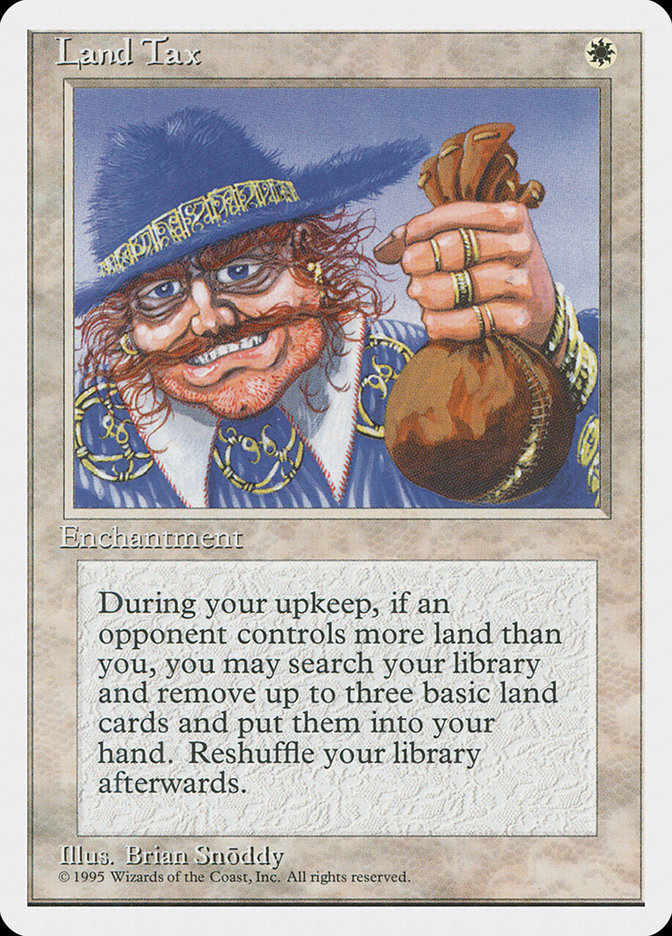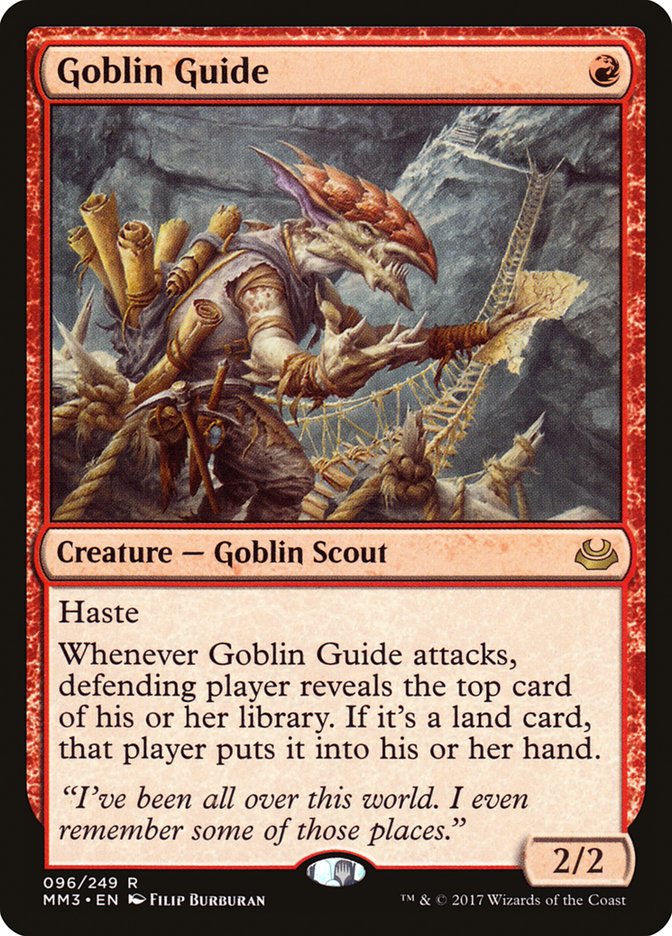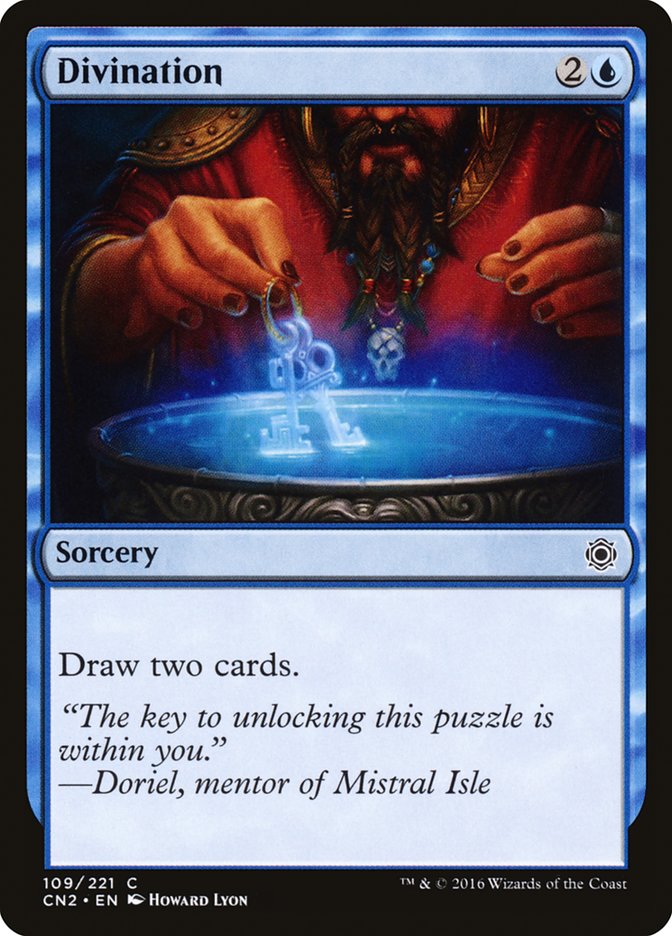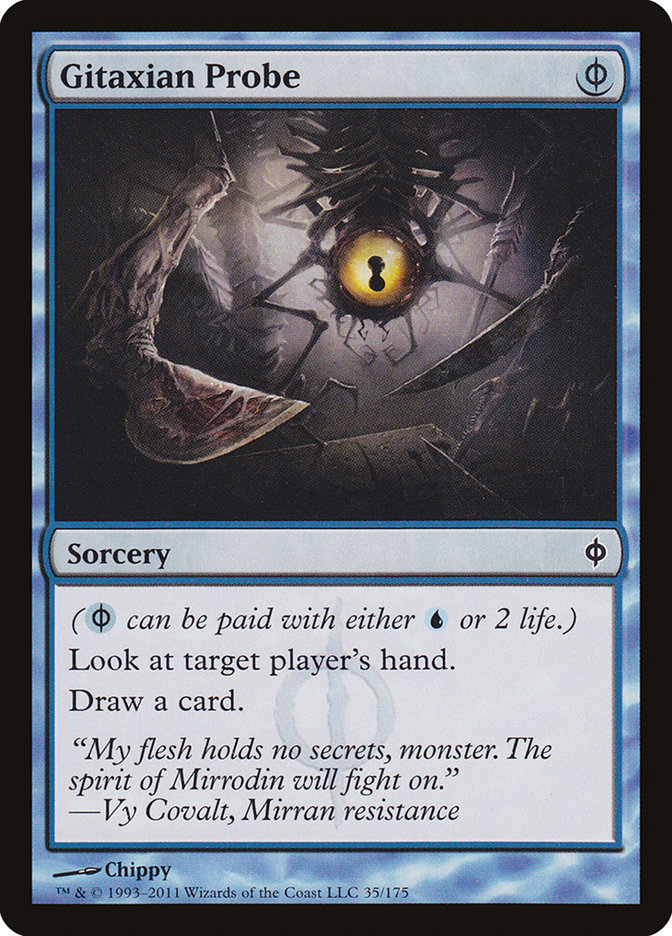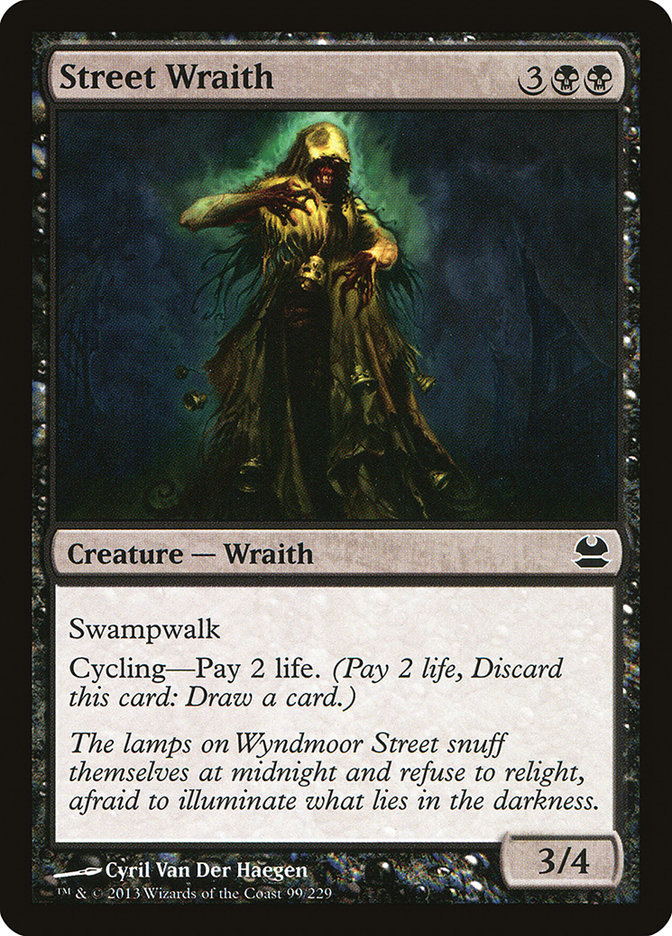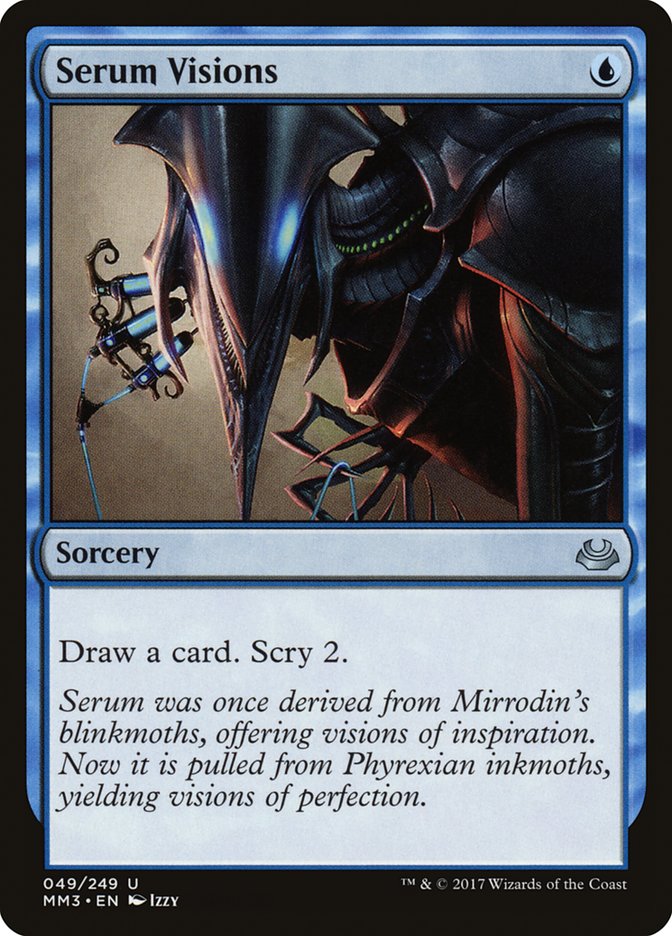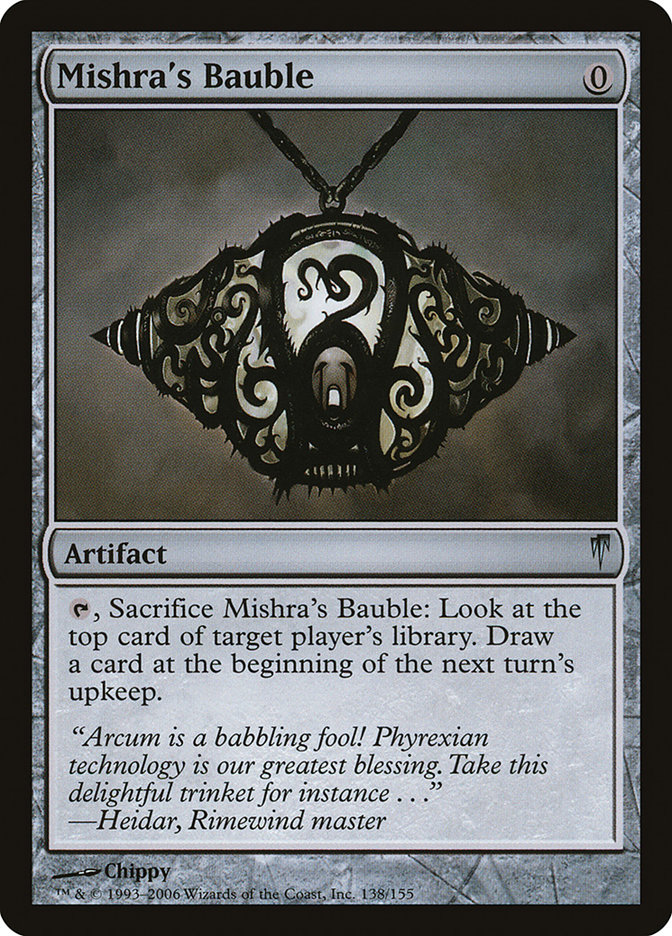Whether in hand or on the battlefield, there’s nothing Magic players like
more than having a card or two. Well, what we really like is having a card
or two more than our opponents, but in the absence of that dream we’ll
settle for having access to as many cards as possible. After all, it takes
money to make money and it takes cards to make cards. You can’t get that
precious two-for-one if you don’t have any cards left yourself.
Magic is a game of decisions. The foundation of good decision-making is
information. Thus, Magic is a game of information. What information? Well,
it all boils down to cards. The cards you have, the cards your opponent
has. The cards you could draw into, the cards your opponent could draw
into. The cards you both can’t draw into. All of this matters for
every decision you make in a game of Magic, but there’s no question that
the most important of these factors is the cards you’ve drawn so far.
The key idea here is that the earlier you draw a card, the earlier it gets
to start influencing your decisions. That card gets to be cast earlier in
the game, and its impact will be felt over the course of many more turns
than if it had been drawn later in the game. In short: the earlier, the
better. It takes cards to make cards, and the more information you have
sooner about what you’re working with, the better equipped you will be to
make decisions that will be to your advantage.
Simple Stuff
Let’s start with the battlefield. These information edges are cool and all,
but they are an insignificant application of the time value of cards
compared to the edges that can be found on the battlefield. For starters:
What’s the best turn to cast this Goblin on? If you said turn 1, and I’m
sure most of you did, you are, of course, right. A Goblin Guide on turn 1
is going to be able to attack more times than one played on turn 2. On turn
1, Goblin Guide might be worth four damage. On turn 2, two damage. And on
turn 3, the little Goblin that could might not be worth any damage at all.
Magic has so many cards that it’s hard to come up with hard and fast rules
that have no exceptions, but for the most part, creatures that you intend
to attack and block with are going to be better the earlier you deploy
them. The first application of this is that you tend to want to play
creatures before spells, but that’s a conclusion we could have reached
without thinking about the time value of cards. More interesting is using
this idea to figure out the best order to sequence creatures in.
Creatures are more impactful the longer they are on the battlefield. The
earlier we play them, the more they get to do. But this isn’t a uniform
power-level gain; some creatures wear the early deployment mantle better
than others, so to speak. So, how so we rank creatures in order of who
benefits the most from a longer battlefield presence so that we can best
sequence them? Well, here’s some things to consider:
Stats.
The difference between two and three power might not seem huge, but applied
across four turns that’s four damage.
Obsolescence points.
Some creatures become irrelevant as the game progresses and need to be cast
early if you want to get any value out of them.
Removal timings.
Sequencing two creatures around your opponent’s removal curve can get you
multiple turns with both creatures instead of just one.
Moving right along, let’s take a look at some spells that feel their
effects multiplied down the turns of the game.
In most matchups, Thoughtseize is by far at its most powerful on turn 1.
Part of the reason is that you are guaranteed a whole hand to look at and
choose from, something that can be hard to find in the later stages of the
game. Anyone who has ever played with discard spells knows the pain of
drawing them late in the game when the opponent no longer has any cards in
hand. But that’s not the main reason I consider Thoughtseize to be
multiplicative.
You get to see their hand on turn 1. That’s huge. It’s the
difference between running through the woods blindfolded while getting
chased by a bear and calmly navigating around the bear den with your
wildlife map and GPS. In that moment, you know everything there is to know
about the state of the game, and you get to adapt your plans to fit. If you
see their hand on turn 6, often it’s only confirming what you already know.
Indeed, a lot of the time that late in the game, your Thoughtseize will
take the only spell left in their hand. The shape of the game is already
decided by this point, and it’s too late to alter it to fit any information
you did gain.
Card draw spells are another class of card that is more powerful the
earlier you cast it. Until you find a window to cast your Divination, all
you know is that you have two cards coming at some point. Once you manage
the three mana, you know what those cards are and can use that information
to sculpt the game to your advantage. You can play those cards soon,
allowing any time value multiplication they have to get started. All other
things equal, you’d rather draw cards as early as possible.
But all other things aren’t equal. The problem with card draw
spells, the reason they aren’t in every deck, is that taking a turn off to
cast them is a very real cost. So when you find yourself staring at a card
draw spell in hand, figuring out when to cast it is an exercise in
balancing competing tensions. You want to cast it as soon as you can, but
you can’t let yourself fall too far behind. The specifics of this timing
depend on the matchup, but in general card draw timing is earlier than you
might think. When at parity or slightly behind is a great time to
Divination.
The Cost of Cantrips
Now it is time to leave the concrete world of casting spells and having
creatures and enter the shadowy realms of pure information. Time value of
information is very simple: you want information as early as possible. The
more information you have, the better decisions you make, the more likely
you are to win the game of Magic you find yourself in.
Enter cantrips. Cantrips are a very popular class of spell in the
non-rotating Magic formats, and for good reason. The more powerful ones
like Serum Visions allow you to sculpt the cards you’re going to have to
work with throughout the game, while we’ve become very familiar with the
power of niche cantrips like Street Wraith in synergy shells like Death’s
Shadow.
But as good as they are, cantrips aren’t all upside. There is a hidden cost
associated with playing them that we don’t often consider. This is the cost
of delayed information. A cantrip in your hand could eventually be
anything in your deck, but until you actually play it you don’t know what
card you will be working with in the future. This makes your decisions
harder. Imagine you have a Thought Scour in hand and your opponent is
attacking you with a small Death’s Shadow. You could Terminate it, but
ideally you would use Fatal Push so as to save Terminate for a Gurmag
Angler. If you pull the trigger on Terminate, and then Thought Scour into
the Fatal Push, you’re going to be sad.
Nowhere is this delayed information cost more apparent than in mulligan
decisions. Staring at a seven card hand with five excellent spells and two
Street Wraiths is a pretty terrible feeling. You just don’t have enough
information to confidently decide if these are the cards you want to play
with. And it’s not always so stark a problem. I’ve seen plenty of
great-looking hands with three lands and two cantrips flood out and lose
after both cantrips find lands. Putting cantrips in your deck greatly
weakens the power of your mulligans, and that’s something you should keep
in mind.
Now, none of this is to say that cantrips are bad and you shouldn’t play
them. That’s just very clearly incorrect. But recognizing that they have a
downside is important, so we can put some thought into how to best mitigate
that downside. All we can do about the mulligan issue is refrain from
putting a truly excessive number of cantrips into our deck and put some
serious out of game work into the mathematics of our keeps, but there is a
lot we can do to make sure we get our in-game information when we need it.
The question, of course, is when are we supposed to cash in our cantrips?
In terms of information, we would like to cast in our cantrips as soon as
possible. The sooner we know what we have in our hand, the more we can do
with it. But we’re putting these cantrips into our deck for a reason, and
sometimes that reason involves a power level that comes in part from
holding onto those cantrips for a little while. So, how do we balance these
competing factors?
Mishra’s Bauble is one of the most interesting cantrips to run this
analysis with. Bauble is a slow cantrip, which heavily encourages playing
it as early as possible since you want to make sure you have the card when
you need it. It’s free to play, so there’s no mana arguments for holding it
back. And yet, still you sometimes don’t Bauble immediately. The main
reason for that is its pseudo-scry synergy with your fetchlands. By holding
your Bauble until a turn when you intend to fetch but could do so on your
turn or theirs, you get to decide if you want to draw the top card of your
library or not.
You might think that that’s a fairly small edge, and you’d be right. But
small edges add up. How do we balance the potential to get a free scry with
denying ourselves information for a few extra turns? In general, holding
cantrips back for value is right whenever you know your plays for the next
few turns are optimal anyway. In Abzan Traverse, if I know my first two
turns are going to be Thoughtseize into Grim Flayer no matter what I draw
off Mishra’s Bauble, I have no qualms about holding the Bauble back a turn
since I don’t need that information right now. My plays are already set.
You can also delay using your cantrips when playing against a discard deck.
Cantrips are remarkably good against Thoughtseize, as you get to deny your
opponent the same information you are denying yourself. Kind of like a
sci-fi plot where the protagonist blindfolds herself to avoid giving away
her location to some technology that can see what she sees. But aside from
discard matchups, cantrip as soon as you can. Don’t hold onto Street Wraith
too long hoping to surprise them with it; trust me, they expect it and
knowing what card that Street Wraith really is will help you.
The Traverse the Ulvenwald Problem
Look, I’ve been playing a lot of Traverse the Ulvenwald lately. I played
the Abzan Traverse deck I
wrote
about to reasonable if unexciting finishes in the last two Modern Opens.
The most recent wave of Standard Grand Prix proved that G/B Delirium is as
reasonable a choice as any non-Aetherworks Marvel deck can be, so you can
be quite sure I’ve been returning to my G/B roots in Standard too. Which is
all just to say that I have become well acquainted with the foibles of
Traverse the Ulvenwald.
In a lot of ways, Traverse the Ulvenwald is like a cantrip. It effectively
draws you a card, and often you don’t know what that card is going to be.
Many times you find yourself with three types in the yard, holding onto
Traverse because you want to use it to grab a creature but can’t do that
yet. Traverse is a split card that incentivizes you heavily to wait for the
second half to be turned on, and that wait denies us information.
I think most of the mistakes I’ve made with Abzan Traverse since picking
the deck up have been not cashing in Traverse for a basic when I should
have. I always want to hold it, to get that creature, and find myself
stumbling along on three lands for far too long, when a fourth would let me
curve beautifully and cast all the spells I want to cast when I need to
cast them. There’s time value of lands too–the longer a land is on the
battlefield the more mana you can get from it since it untaps every turn.
In general, I would recommend Traversing for a basic the first turn you
would miss your land drop. It’s one thing if you’re flooded; another
entirely if you decide you can function well enough on a sub-optimal number
of lands and stubbornly hold onto it waiting for a delirium that comes too
late. Just like a cantrip, the sooner you decide what this Traverse is
going to be, the better off you are.
If there’s one thing to take away from this article, it’s that the more
information you can gather, the better off you are. The sooner you have
that information, the better off you are. Remember that cards are not
valuable just at discrete points in time, but they accumulate value across
turns. Maximizing that accumulation is something to keep in mind while
sequencing your cards.


